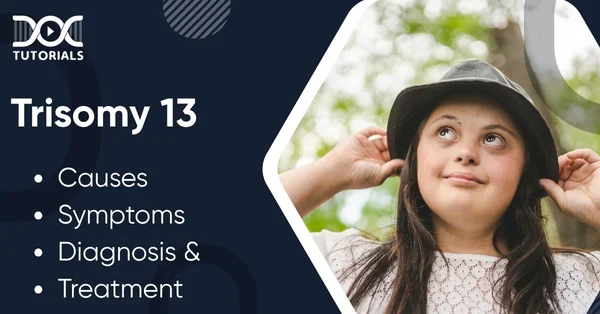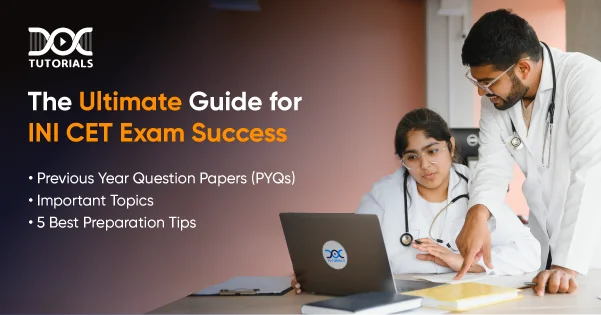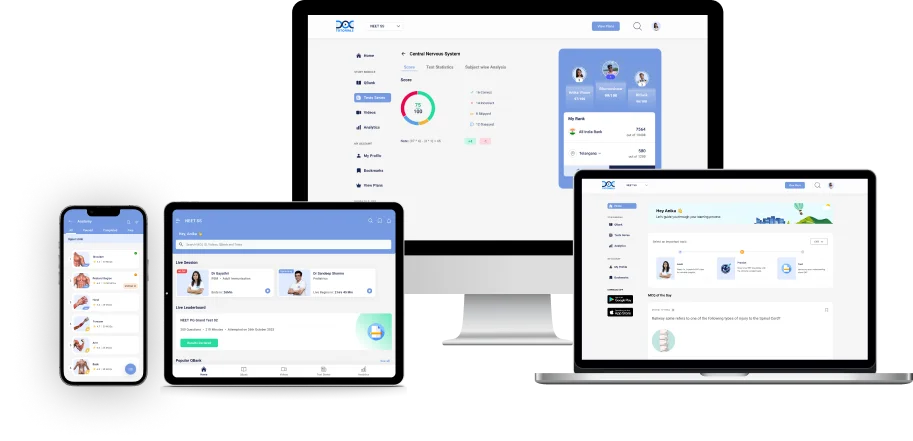Trisomy 13: Types, Risk Factors, Symptoms, Diagnosis, and Treatment

Trisomy 13, often called Patau Syndrome, is a rare chromosomal disorder caused by an extra copy of chromosome 13 in the cells. In 1960, the condition of triplet autosomal trisomy was recognised, and it often results in severe developmental difficulties.
Trisomy 13 affects about 1 out of 10,000 to 20,000 newborns. More often than boys, girls are affected by meiotic errors that develop by chance. It involves several parts of the body, is usually spotted before or at birth, and is likely to be fatal.
Trisomy 13 is essential if you’re a medical student preparing for the NEET PG exam. Keep reading for detailed insight.
What are the Types of Trisomy 13?
Trisomy 13 has a variety of genetic forms, which are listed below in depth:
- Complete Homotrisomy: The typical case (about 80%–90% of children) is complete nondisjunction, in which every cell has three copies of chromosome 13 (a 47, XY,+13 or 47, XX,+13 karyotype)
- Robertsonian Translocation: In one out of five cases, a part of chromosome 13 fuses to another chromosome as gametes are produced. When a parent has a balanced translocation, it increases the chance of the condition happening in other family members.
- Mosaic Trisomy 13: In a few rare cases, some cells in the body have an extra chromosome, and others do not. Mosaicism usually results in milder features, but its severity is hard to predict.
What are the Risk Factors of Trisomy 13?
The disorder usually results from errors in the development of reproductive cells. The main conditions and risk factors involved in Trisomy 13 are explained below.
- Nondisjunction Error: Trisomy 13 develops because of nondisjunction, an error in meiosis, the cell division process when eggs or sperm are made. Because of this error, the embryo has three copies of chromosome 13.
- Maternal Age: Being pregnant at an older age is linked to increased risk. As for women over 35 years old, the eggs are more likely to make meiotic mistakes. A higher number of pregnancy-related Trisomy 13 is recorded for women who are older at the time of conception.
- Paternal Age: While older paternal age is considered, its role is usually minor compared to the maternal age.
- Genetic Translocations: Carrying a balanced Robertsonian translocation on chromosome 13 increases the chance of having a child with Trisomy 13.
- Recurrence Risk: If a nondisjunction caused the condition, it is unlikely to occur again in the next pregnancy, with a chance of less than 1%.
What are the Symptoms of Trisomy 13?
Trisomy 13 is linked to several defects affecting the brain, face, heart, limbs, and other organs at birth. The main clinical Patau syndrome symptoms and frequently related anomalies are as follows:
General Characteristics
- Infants frequently weigh less than expected for their age.
- Severe neurological impairment is common.
- Presence of unusual and distinctive facial or bodily features (dysmorphisms)
Brain and Skull Abnormalities
- A condition called holoprosencephaly, where the forebrain fails to divide, leading to microcephaly.
- About 39% of cases include neural tube defects and midline brain anomalies.
- Scalp defects that include cutis aplasia (the lack of skin on the scalp)
Facial Abnormalities
- Eyes located close together or even fused (hypotelorism or cyclopia in extreme cases)
- Cleft lip or palate.
- Low-set or malformed ears.
Limb Abnormalities
- Polydactyly (additional finger or toe)
- When fingers are clenched, they often overlap.
- Rocker-bottom feet (a rounded appearance of the soles)
Internal Organ Defects
Approximately 50% of infants experience congenital heart defects, such as:
- Ventricular septal defect (VSD)
- Atrial septal defect (ASD)
- Patent ductus arteriosus (PDA)
- Renal (kidney) malformations are frequently seen.
- Problems related to the gastrointestinal tract can occur, including abdominal wall defects.
The table below summarises some reported prevalences of Patau-associated findings:
| Symptoms | Approximate Prevalence |
| Congenital heart defects | 50–60% |
| Nervous system anomalies | ~39% |
| Eye anomalies | ~30% |
| Polydactyly | ~44% |
| Orofacial clefts | ~45% |
Clinically, a newborn with Trisomy 13 is floppy and may have feeding and respiratory difficulties. There is a profound developmental delay. Many pregnancies end in miscarriage or stillbirth; among live-born infants, most die within days.
What is the Diagnosis of Trisomy 13?
Trisomy 13 is diagnosed through genetic testing. While certain physical and ultrasound features can raise suspicion, a definitive diagnosis requires chromosomal analysis. Below are the key diagnostic approaches:
- Postnatal Diagnosis via Karyotyping: Three copies of chromosome 13 are examined during the analysis of a blood sample from the newborn.
- Prenatal Diagnosis via Invasive Testing: If doctors suspect Trisomy 13 during pregnancy, they can perform amniocentesis or chorionic villus sampling (CVS) to obtain a tiny sample of fetal cells for testing.
- Non-invasive Prenatal Testing (NIPT): Testing a mother’s blood for cell-free fetal DNA (deoxyribonucleic acid) may indicate an increased likelihood of Trisomy 13 in early pregnancy.
- Maternal Serum Screening: Blood tests that measure certain proteins and hormones can detect a higher risk of chromosomal abnormalities such as Trisomy 13.
- Ultrasound Findings: Prenatal ultrasound findings of oligohydramnios, prosencephalon, cardiac dysfunction, or lower-than-normal fetal growth may suggest Trisomy 13.
- Clinical Evaluation at Birth: Doctors may use genetic testing to determine the diagnosis when a newborn displays particular signs.
What are the Treatment Options for Trisomy 13?
There is no cure for Patau syndrome; treatment is entirely supportive, symptomatic, and multidisciplinary. Below are the key aspects of care and prognosis:
- Supportive and Symptomatic Treatment: Medical care is meant to control symptoms and comfort the patient, but it is not curative.
- Multidisciplinary Approach: Neonatology, cardiology, neurology, genetics, and palliative teams are usually involved in care.
- Basic Medical Support: Treatment includes ventilatory help, nutritional help, control of seizures, and taking steps to prevent infections.
- Targeted Interventions for Specific Defects: If the baby is healthy enough, treatment options for cleft lip or palate or congenital heart problems may include surgical repair.
- Selective Surgical Management: Several hospitals carry out heart surgery when necessary, though most doctors prefer to keep treatments simple, given the risks.
- Therapies to Enhance Comfort and Function: Physical, occupational, and speech therapy may help infants who survive longer in development and feel comfortable.
- Early Palliative and Social Support: Counselling, hospice, and palliative care are given early to families so they can be supported emotionally and guided in their decisions.
What are the Prevention Strategies for Trisomy 13?
Trisomy 13 arises from a chromosomal error, so no direct prevention methods exist. However, there are other safety measures you can consider, such as:
- Genetic counselling is important for those individuals who have already had a child with a translocation or who carry the condition themselves.
- Women who are expecting at an older age should understand their risk and be informed that prenatal screening is available.
- If a Robertsonian translocation is found in a parent, consider using preimplantation genetic diagnosis during IVF (in vitro fertilisation) to prevent passing it on.
FAQs About Trisomy 13
- How is Trisomy 13 diagnosed?
A definitive diagnosis is performed by karyotyping fetal or infant cells. An abnormal ultrasound or a positive non-invasive prenatal test prompts diagnostic tests for chromosomal abnormalities. Postbirth, multiple congenital anomalies led to a chromosome study displaying three copies of chromosome 13.
- What is the chance of having another affected child?
The recurrence risk is low if the first case is due to a random trisomy. However, if one parent is found to carry a balanced translocation involving chromosome 13, the risk of recurrence can be much higher.
- How long do babies live with Patau syndrome symptoms?
Unfortunately, the prognosis is poor. Most infants die in the first days or weeks of life. Median survival is only about 2–3 days. Only about 5 to 10% survive past a year. Rarely, a child may live into later childhood under intensive care, but long-term survival is exceptional.
- Are there any treatments or cures?
There is no cure for Trisomy 13. Treatment focuses on medical care to relieve symptoms and support the child’s needs. Interventions may include respiratory support, feeding assistance, anticonvulsant medications, and surgeries to correct anatomic defects.
Conclusion
Though uncommon, Trisomy 13 or Patau syndrome poses complex diagnostic and ethical challenges that require sound clinical knowledge and empathetic decision-making. DocTutorials’ NEET PG study materials, top-grade video lectures, QRP (Quick Revision Programs), etc., can help you learn more about Trisomy 13 and other vital details.
Want to secure top rank in NEET PG? Enrol in our NEET PG course today!
Latest Blogs
-

NEET PG Exam 2025- Date, Pattern, Marking Scheme, Subject Wise Weightage, and Exam Mode
NEET PG Exam 2025 is the ultimate gateway for medical graduates aspiring to pursue postgraduate courses in medicine, including MD,…
-

INI CET Exam 2025: Your Roadmap to Success – Key Topics, Strategies, and Lessons from Last Year’s Papers
The INI CET exam is more than just a test; it’s a significant milestone for many medical students aiming to…
-

INI CET Exam Success: Previous Year Question Papers & Ultimate Guide – INI CET PYQ
One can feel overwhelmed while preparing for the INI CET (Institute of National Importance Combined Entrance Test). A vast syllabus,…




